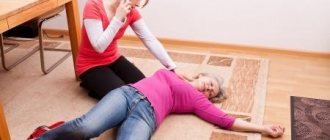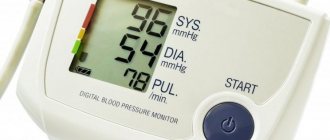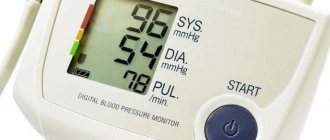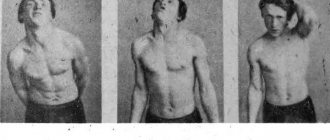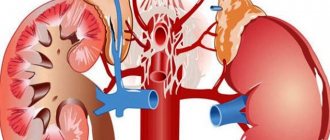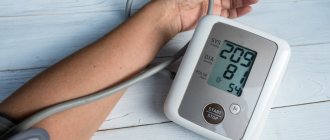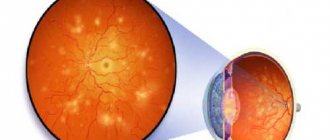Orthostatic collapse (synonymous with orthostatic hypotension) is a condition characterized by a sharp decrease in blood pressure and the development of fainting. Most often, orthostatic collapse occurs in individuals with weakened venous tone during a sudden change in body position (when getting out of bed) or prolonged standing.
Sudden change in body position
Overview of Orthostatic Collapse
Orthostatic collapse is a pathological condition that develops during a sudden transition of the body from a horizontal to a vertical position. Due to a drop in vascular tone and a decrease in circulating blood volume, acute vascular insufficiency develops, which is why the nerve cells of the brain do not receive enough oxygen. Collapse is accompanied by severe dizziness, which often ends in a short-term loss of consciousness.
Frequent fainting may indicate serious problems in the body. Sometimes orthostatic collapse is caused by a drug the patient is taking. The causes, as well as the severity of the pathology, may vary.
A similar disorder is observed in both adults and elderly patients, as well as in children. For example, this is a common occurrence among teenagers. In 23% of people over the age of 60, short-term collapses are observed.
Prevention
To prevent orthostatic collapse, the following is necessary:
- Moderate food intake, with limited carbohydrates, is especially recommended for patients who experience orthostatic collapse after eating.
- A gradual change in body position from horizontal to vertical, especially if orthostatic hypotension occurs after standing up abruptly.
- Constant moderate physical activity in the fresh air, if orthostatic hypotension has developed due to weakness of the autonomic nervous system. This especially applies to children, in whom attacks of orthostatic hypotension are temporary and go away with age and strengthening of the nervous system.
- Clinical observation, control of chronic diseases causing orthostatic hypotension.
The main reasons for the development of the disease
There are many known factors that can lead to short-term fainting:
- Causes include diseases of the cardiovascular system, including aortic stenosis, thromboembolism, cardiomyopathy, pericarditis, severe forms of varicose veins, and myocardial infarction.
- Orthostatic collapse can also be caused by blood loss, including internal bleeding.
- The causes include primary neuropathies, in which there is a disruption of the peripheral nervous system. Similar pathologies are observed, for example, in Parkinson's disease.
- Orthostatic collapse is observed in patients with secondary neuropathies, which, in turn, develop against the background of severe vitamin deficiencies, autoimmune reactions, paraneoplastic syndromes, diabetes mellitus, alcoholism, and porphyria.
- The list of reasons includes taking medications. Drugs that cause orthostatic collapse are nitrates, diuretics, barbiturates, calcium antagonists, quinidine, some antidepressants and antineoplastic agents.
- Collapse occurs in patients with anemia, dehydration and infectious diseases.
- Problems with the adrenal glands are also accompanied by fainting (pheochromocytoma, primary hyperaldosteronism, adrenal insufficiency).
- Short-term collapse can be the result of excessive consumption of foods that lower blood pressure, as well as prolonged bed rest, circulatory disorders due to compression of blood vessels (for example, from wearing a narrow corset).
As you can see, there are a huge number of factors that provoke orthostatic collapse. It is important to find out the causes of fainting, because the treatment regimen will depend on this.
Symptoms and causes of development
The main symptoms that characterize orthostatic hypotension appear not only during a change from a sitting or lying position to a sitting position. They can also occur when you have to stand still for a long time. Hot weather or severe physical and emotional stress can also cause symptoms of hypotension.
Among them:
- Dizziness and headaches.
- Urge to feel sick.
- Decreased hearing and vision.
- Severe sudden weakness.
- More sweat than usual.
- Cramps.
- Increased heartbeat and other heart rhythm disturbances.
- Difficulty breathing.
- Fainting.
- Involuntary urination.
If at least some of these symptoms coincide at the same time, we can assume the development of classic hypotension.
The causes of orthostatic collapse are:
- sudden changes in posture when the body does not have time to adapt to changes in body positions;
- long-term use of medications used to combat cardiovascular diseases and too high blood pressure levels, diuretics;
- overdose of alcoholic beverages;
- use of marijuana and other drugs;
- severe dehydration;
- long bed rest;
- physical and emotional stress;
- diets and exhaustion of the body;
- development of infectious diseases, both viral and bacterial;
- development of anemia;
- development of diabetes mellitus;
- development of atherosclerotic problems;
- development of endocrine diseases;
- using backpacks whose straps put pressure on the carotid artery;
- excessive consumption of chokeberry juice;
- overeating, especially if it happens on a regular basis.
Orthostatic collapse can also occur as a result of fairly harmless hormonal changes in the body, which also affect the condition of blood vessels and their elasticity:
- during pregnancy, especially in the first two trimesters;
- in adolescents during the period when puberty occurs;
- in women in menopause.
All these cases can also cause symptoms of hypotension to appear.
Development mechanism
Research in this area is still ongoing. Today scientists know that orthostatic collapse can develop in two scenarios:
- Many patients experience a decrease in the tone of the venous and arterial walls. This happens if unfavorable factors (for example, toxins, infections) affect the vascular wall, nerve receptors or vasomotor center. In this case, relaxation of the walls of blood vessels and a pathological increase in their capacity are observed. Blood accumulates in the peripheral vessels, which leads to a decrease in blood volume in the heart and a sharp drop in blood pressure.
- Orthostatic collapse may be associated with a severe decrease in circulating blood volume (for example, during bleeding). Due to insufficient blood flow to the heart, the microcirculatory system is disrupted, as a result of which fluid begins to accumulate in small capillaries, only further worsening the situation. Due to an insufficient amount of oxygen in the tissues, hypoxia and acidosis develop, which leads to an increase in the permeability of the vascular wall. With such a pathology, not only oxygen deficiency is dangerous, but also the formation of blood clots.
Causes
Normally, the human cardiovascular system ensures relative constancy of blood pressure when changing posture. The compensatory mechanism of a healthy body works so that when the body position changes from horizontal to vertical, the heart rate increases, and the vessels of the lower extremities slightly spasm, pushing blood upward.
Orthostatic (postural) hypotension, or orthostatic collapse, occurs as a result of an untimely response of the cardiovascular system to a change in the state of the body in space, which causes a decrease in pressure in the vessels, insufficient blood flow to the brain and, as a result, its oxygen starvation.
Orthostatic hypotension, the causes of which may lie in numerous pathologies, is most often caused by:
- a decrease in the volume of circulating blood - this condition has the medical name hypovolemia and occurs as a result of insufficient fluid intake into the body, excessive blood loss, taking diuretics or drugs that relax the smooth muscles of the walls of blood vessels;
- side effects from long-term courses of treatment with antihypertensive drugs or antidepressants, including monoamine oxidase inhibitors and tricyclics;
- diseases accompanied by damage to the vascular system, narrowing of the lumen of the arteries, endocrine diseases, such as chronic adrenal insufficiency, adrenal tumor, diabetes mellitus;
- conditions associated with a sharp decrease in body weight (anorexia, bulimia, nervous exhaustion);
- neurological pathologies (vegetative-vascular dystonia, parkinsonism, multisystem atrophy caused by degeneration of nerve cells in certain areas of the brain).
The disorder can occur in any person after a long stay in a horizontal position, especially for the elderly and women in labor, as well as any person with weakened vascular tone. Often the phenomenon of orthostatic hypotension is observed in teenage girls or young girls, which is associated with uneven growth of the heart and blood vessels during this period.
Important information: List of medicinal herbs (plants) that increase low blood pressure during hypotension
Tight bandaging of the lower extremities, which is done for insurance by climbers, bungee jumpers, construction workers and others whose work involves heights, can impede the flow of blood towards the heart and cause symptoms of orthostatic hypotension. For the same reason, a tight corset can impede blood flow.
Classification: types of orthostatic collapse
This pathology is classified depending on the causes of its occurrence. In addition, there are three degrees of severity:
- The first (mild) degree of collapse is accompanied by dizziness when changing body position and a pre-fainting state. But the person does not lose consciousness.
- The second degree (moderate) is characterized by rare, episodic fainting, which occurs during a sudden attempt to get up or as a result of prolonged standing.
- The third degree is the most severe. Patients experience frequent loss of consciousness, which occurs even in a sitting position. Fainting occurs when standing motionless for a short time.
When diagnosing, the nature of the course of the disease is also taken into account, identifying several forms:
- Acute orthostatic hypotension is accompanied by episodic fainting and weakness that lasts several days or weeks, as it is caused by temporary disturbances in the functioning of the autonomic nervous system. This form is usually associated with taking certain medications, toxins or infections entering the body.
- Chronic hypotension is said to occur when collapses recur over several months. The pathology is usually associated with diseases of the nervous, endocrine or circulatory system.
- Progressive chronic hypotension develops over years, and its causes are still poorly understood.
Classification by severity
Like many other diseases, orthostatic hypotension varies in severity . The tactics of its treatment may depend on determining the stage of the disease. Today, medicine distinguishes three degrees of this condition:
1 Degree - mild, manifested by periodically occurring pre-fainting conditions.- 2nd degree - moderate course. When placing the body in an upright position or after standing for a long time, episodic fainting occurs.
- 3rd degree - severe. Fainting occurs frequently and can occur even when the patient is sitting or half-sitting.
Even if a person notices signs of mild hypotension, he should be examined by a doctor. After all, sometimes these symptoms indicate the presence of some kind of pathology that has just begun to develop.
Mild collapse and its symptoms
What signs are accompanied by orthostatic collapse? Symptoms directly depend on the degree of hypotension and the reasons for its development. If we talk about the mild form, it is characterized by sudden but rapidly increasing weakness, blurred vision, and blurred vision. Patients note the appearance of dizziness, which is accompanied by a feeling of falling through - this is a pre-fainting state.
If the collapse is caused by prolonged standing, then additional symptoms may appear, in particular, chills, sweating and nausea. The mild stage rarely ends with loss of consciousness.
What do the symptoms look like?
There are several signs of a problem such as orthostatic collapse. Symptoms relevant for this diagnosis are as follows:
- dizziness;
- loss of consciousness;
- feeling of emptiness or heaviness in the head;
- sudden weakness;
— a veil before the eyes or flashing of flies;
- central vomiting or nausea;
- if we are talking about a severe case, then involuntary urination and the development of convulsive syndrome are possible.
A problem such as orthostatic collapse can develop against the background of impaired blood supply not only to the brain. In this case, you should pay attention to symptoms such as angina pectoris (signs of myocardial ischemia), pain in the neck muscles and changes in breathing.
The occurrence of such symptoms is possible both during prolonged stay in an upright position and in the event of a sudden change in body position. Strong and sudden physical activity can also lead to fainting. In some cases, signs of hypotension may occur after eating a large amount of food. This is explained by the activation of the vagus nerve.
Moderate degree of pathology
Orthostatic collapse begins with dizziness and severe weakness. A person's skin quickly turns pale, and the extremities (especially the fingers) become very cold. Patients note the appearance of cold sweat on the neck and face. Palms become wet.
A sharp decrease in systolic pressure and the development of tachycardia are possible. Often, a moderate degree of collapse is accompanied by loss of consciousness for several seconds. During fainting, involuntary urination may occur. Symptoms usually come on gradually, so the person has a few seconds to sit down, lean on him, or take other precautions.
Symptoms
Orthostatic collapse is preceded by sudden weakness, exhaustion, heaviness in the abdomen, coldness of the extremities, a surge of thirst, and sweating. The patient's face is pale, as are the mucous membranes, cold sweat comes out all over the body, the veins in the arms and legs are in a state of collapse, the pulse is weak and thready.
Orthostatic collapse can cause loss of consciousness. First, the patient’s vision becomes dark, then fainting occurs.
The main symptoms of severe orthostatic collapse
Severe collapse is also accompanied by the disorders described above. The only difference is that they appear instantly. The person suddenly loses consciousness, which is fraught with additional injuries if they fall. Fainting in patients is deeper and longer lasting.
During loss of consciousness, urination occurs frequently. Fainting is often accompanied by convulsions. The patient's skin is very pale and his breathing is shallow. In such cases, the patient needs urgent medical attention.
Possible complications
Drop in blood pressure during fainting
If the cause of vascular disorders and collapse is not found, then frequent fainting can be complicated by serious injuries from a fall.
In severe cases, the following complications may develop:
- ischemic stroke – caused by prolonged oxygen deprivation of parts of the brain;
- development and worsening of neurological diseases against the background of prolonged brain hypoxia;
- dementia.
Diagnostic methods
The task of diagnosis in this case is to determine the root cause of the development of collapse. For this purpose, the doctor collects a complete medical history and finds out what diseases the patient and his relatives suffer from. Blood pressure must be measured, both in a standing and lying position. The specialist also examines the veins and listens to heart sounds. A blood test helps determine the presence of anemia and electrolyte imbalance. The blood is also tested for cortisol levels.
As for instrumental analyses, electrocardiography is performed first to detect rhythm disturbances. Echocardiography allows a specialist to check the condition of the myocardium and heart valves. Orthostatic tests are carried out, which demonstrate the body's response to changes in body position. The patient needs to be examined by a neurologist to diagnose neurological diseases.
Diagnostics
Diagnosis of orthostatic hypotension is based on:
- analysis of medical history and family history;
- examination, including measuring blood pressure in the supine and standing positions at 1 and 3 minutes after 5 minutes of lying at rest, listening to the heart, examining the veins, etc.;
- general and biochemical blood tests to detect anemia, water-salt imbalance, etc.;
- hormonal analysis to determine cortisol levels;
- Holter monitoring of cardiac activity;
- orthostatic test, which allows us to identify the reaction of the cardiovascular system to a change in body position.
Methods for diagnosing orthostatic hypotension also include:
- ECG, which allows to identify concomitant pathologies;
- consultation with a neurologist to help exclude other neurological diseases (this is especially important against the background of the development of seizures during fainting);
- vagal tests, revealing the presence of excessive influence of the autonomic nervous system on cardiovascular activity;
- Echocardiography, which helps evaluate the condition of the heart valves, the size of the walls of the heart muscle and the heart cavity.
Orthostatic collapse: emergency care
Of course, the person needs help. If you lose consciousness, you should call an ambulance. While waiting for doctors, the patient should be laid horizontally, preferably on a hard surface. The legs need to be elevated using a pillow or bolster.
Since fainting is associated with a lack of oxygen in the brain, you need to ensure an influx of fresh air (if you are indoors, you can open a window or door). Clothing that restricts the patient's movement or compresses blood vessels should be removed or unfastened. You can sprinkle cool water on the person's face and chest. You can bring a patient out of a fainting state using ammonia (smelling salts).
Treatment
First aid for orthostatic collapse includes:
- placing the patient in a horizontal position on a hard surface (legs elevated);
- ensuring a flow of fresh air;
- removal of restrictive clothing;
- splashing the face and chest with cold water;
- use of ammonia.
1-2 ml of cordiamine or 1 ml of 10% caffeine solution is injected subcutaneously. Vasodilators are contraindicated.
After regaining consciousness, the patient should be given warm tea or coffee with sugar.
Further therapy depends on the severity and nature of the disease causing orthostatic collapse.
Orthostatic collapse: treatment
As you have already understood, this is a rather dangerous condition that can be a symptom of a serious illness. What to do if orthostatic collapse occurs? Treatment depends on the cause of fainting.
In order to narrow the blood vessels and increase the pressure in the arteries, the patient is injected with a solution of caffeine or cordiamine. After the patient has regained consciousness, tests and analyzes are carried out. In mild forms of the disease, sometimes it is enough to watch your diet and not overwork. Medicines are selected individually. For example, if the cause of collapse is anemia, then the patient is prescribed iron-containing medications. For persistent hypotension, vasoconstrictor drugs are used. If there is stagnation of blood in the vessels of the extremities (observed with varicose veins), patients are recommended to wear compression garments.
Treatment methods
In order to overcome orthostatic collapse, treatment must be carried out competently and with the participation of a qualified specialist. In general, methods of influencing this problem can have two main directions: lifestyle changes and the use of drug therapy.
If we talk about natural recovery methods, these include the following:
- eating small portions of food;
- short stay in hot places;
- formation of a hill under your feet during sleep with the help of pillows;
- use of isotonic loads for all muscle groups;
- frequent walks in the fresh air;
— if circumstances require it, compression hosiery is used, which helps maintain the tone of the veins located in the lower extremities;
- protection from sudden rise from a bed or chair (first you need to lower your legs and only then take a vertical position).
For treatment with medications, erythropoietin, vasopressin analogs ("Vazomirin", "Minimirin"), mineralocorticoids ("Deoxycortone", "Florinef"), cholinesterase inhibitors ("Galantomin", "Prozerin"), etc. are used. But you should always remember that that orthostatic collapse can be caused by a drug that was used without taking into account contraindications in the case of a particular patient or with an incorrect dosage.
Do not forget about the underlying disease, which may be the cause of collapse. Without its treatment, it is unlikely that significant results will be achieved.
Preventive methods
Prevention of orthostatic collapse is simple - you just need to follow some simple rules:
- It is very important to identify and eliminate the cause of frequent collapses - all diseases must be adequately treated in a timely manner.
- Patients are advised to sleep on comfortable mattresses with the top raised (so that the head and shoulders rest higher) and to rise slowly from the bed.
- It is important to eat right, make sure there are enough vitamins in your food, and maintain the correct water balance.
- You need to create a suitable work schedule, maintain a regime of physical activity and rest.
- Therapeutic gymnastics has a beneficial effect on the patient’s condition.
- It is worth giving up medications and foods that cause a decrease in blood pressure.
If you have any symptoms, you should seek help from a specialist and do not skip regular preventive medical examinations.
Main symptoms of fainting
Even before losing consciousness, a person usually feels an attack of lightheadedness, a veil appears before his eyes, he feels nauseous, there is a ringing in his ears, and there are spots in front of his eyes. Precursors of fainting are: sudden weakness, in rare cases, yawning, and patients' legs give way, as well as weakness and a feeling of approaching fainting. Characteristic symptoms of fainting are: pale skin, cold sweat, and in some people even a slight blush may persist. And after loss of consciousness, a person’s skin acquires a slightly gray tint, the pulse has weak filling, pressure drops, heart rate may decrease or increase, tone becomes low, reflexes are absent or sluggish. During fainting, the pupils dilate and react slowly to light. Symptoms of fainting continue, but on average last 1-2 seconds. During prolonged fainting, the time lasts up to 5 minutes, but convulsions may begin or involuntary urination may occur.
Manifestations of orthostatic hypotension
Orthostatic disorders are manifested mainly by signs of impaired blood supply to the brain. With a sudden change in body posture, a person feels severe weakness, dizziness, the eyes become dark, “spots” flash, nausea, noise, and pulsation in the head are possible. The heart responds to decreased blood flow by pumping faster, so you may experience a rapid heartbeat. Many people point to a feeling of falling into emptiness, after which, in the event of fainting, there are no memories.
Approaching hypotension during prolonged standing is indicated by a feeling of nausea, the appearance of sticky sweat, dizziness, pale skin, a desire to lie down or, conversely, move a little.
If the vessels manage to react relatively quickly, then everything ends with the listed symptoms, dizziness quickly disappears, and normal well-being returns. Tachycardia helps normalize blood flow and provide the brain with the necessary oxygen. When the process of vascular adaptation is delayed, the symptoms intensify, and the person loses consciousness - fainting occurs.
Fainting with orthostatic hypotension is often short-term, without disturbances from other organs and systems, and goes away on its own within 1-2 minutes. After fainting, some weakness, weakness, and headache are possible. Since consciousness is lost, the person who has suffered orthostatic collapse does not remember anything, but knows that everything happened after he abruptly got out of bed or stood for a long time, for example, in a queue.
With prolonged orthostatic insufficiency, fainting can be quite deep. Due to severe hypoxia, brain neurons are damaged, convulsions and involuntary emptying of the bladder are possible. In this case, the patient can also explain little due to the lack of consciousness.
Symptoms of orthostatic hypotension often develop in the morning. This is understandable, because people usually get out of bed in the morning. Daytime naps or simply lying down for a long time followed by a sudden rise can also cause fainting.
The environment also predisposes to hypotension. For example, if you stand for a long time in a stuffy room or transport without the opportunity to walk at least a little, it is very likely that you may faint. In the hot season, hypotension occurs more often, especially in those who do not tolerate heat well or suffer from concomitant pathology of the heart or blood vessels.
If suddenly in a public place under the conditions described above, a stranger turns pale and begins to fall, there is no need to panic. In most cases, this occurs due to orthostatic disorders. People around you usually give up their seat in the transport or call an ambulance during a prolonged episode of loss of consciousness.
Pregnant women are a special category of people. Their pressure fluctuations occur quite often. Expectant mothers can be very sensitive to heavy loads and weather conditions; prolonged standing is contraindicated for them. They deserve special attention due to the high risk of falling and injury due to fainting, which can disrupt the normal course of pregnancy and harm the baby. When you see a pregnant woman standing on the bus, it is better to give her a seat, although there are still many who will turn to the window or seem to not notice her “interesting position.”
After a few minutes, the condition gradually normalizes, tachycardia decreases, and the brain, as they say, “clears up.” If a person faints and falls, they may notice signs of impacts on surrounding objects or the floor - “bumps” on the head, painful bruises on the limbs or torso.
In some cases, hitting the head at the time of loss of consciousness and falling leads to severe headaches, even if the pressure is completely normalized. In such cases, the doctor has to rule out a traumatic brain injury by referring the patient for various examinations.
If orthostatic hypotension occurs in a patient with coronary heart disease, then at the moment the pressure decreases and even after its recovery, pain in the heart (angina pectoris) may be felt, because it too does not receive enough nutrition. Impaired blood flow can cause shortness of breath.
Depending on the frequency of hypotension attacks and their severity, there are several degrees of orthostatic pressure disorder:
- At the initial stage, hypotension does not reach the state of fainting and occurs rarely.
- Moderate orthostatic hypotension occurs with periodic shallow fainting on the background of long standing or rapid rise from a lying position.
- Severe hypotension leads to frequent deep loss of consciousness, which can occur even in a semi-sitting position, after short-term standing.
With moderate hypotension, not only tachycardia is possible, designed to compensate for changes in blood flow. In some cases, both pressure and pulse decrease, which becomes thread-like and difficult to palpate.
If hypotension appears against the background of dysfunction of the autonomic nervous system, an infectious disease, or poisoning, then its episodes gradually decrease and disappear completely. In case of chronic pathology of the heart, nervous system, endocrine organs, orthostatic collapse will also be chronic, recurring periodically. In idiopathic hypotension, when the cause has not been determined, orthostatic disorders have a constant progressive course.
Orthostatic hypotension itself may not be life-threatening, especially if the attacks are short-lived and the fainting is shallow. At the same time, there are certain risks, and pathological complications are possible.
The greatest danger as complications is represented by injuries received during a fall - bruises, hematomas, concussions, etc., as well as possible strokes, especially in predisposed individuals (elderly people with atherosclerosis of the vessels of the head).
With prolonged and frequent fainting, brain tissue suffers, so over time, chronic ischemia may develop, and the patient will begin to experience difficulties with mental activity, become tired and irritable.

